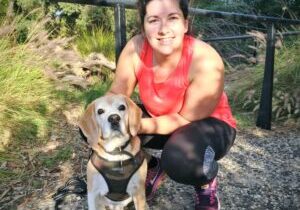How to overcome a fear of dogs: The science of beating cynophobia

What is cynophobia?
The disproportionate fear of a particular object or situation, which causes clinically significant distress or impairment in functioning, is called a specific phobia. Specific phobia is one of the most common types of mental health difficulties that people face, affecting at least 1 in 8 individuals in their lifetime.1
Animal phobias are among the most common categories of phobias - and a phobia of dogs is one of the most common animal phobias, along with fear of snakes and spiders. However, unlike spiders and snakes which are rarely encountered, depending where you live, dogs can be found in almost any public space, making a fear of dogs particularly distressing and debilitating for sufferers.
Fortunately, there is a highly effective, and relatively short-term, psychological therapy that works for the vast majority of children and adults suffering from a specific phobia.
What does therapy look like?
The 'gold standard' psychological treatment for animal phobias, like cynophobia, is a type of behaviour therapy known as exposure therapy.
In exposure therapy, the client is assisted by an experienced clinician to approach the object or situation that they fear while being coached on how to deal with their anxiety.
This can be done very gradually, over a number of sessions, or in a single prolonged session, depending on the individual’s readiness to progress. Importantly, the client is never pushed into situations they are unwilling to encounter, and the clinician seeks their consent at every stage.
Done correctly, this process should feel positive, empowering and even fun! After all, it would be completely counter-productive if it was a highly stressful or terrifying experience.
Over the course of therapy, these new positive learning experiences help to alter the client's fear response, so that it is no longer triggered by the presence of a dog.
Additionally, because dogs are intelligent animals with their own feelings and behavioural responses, therapy for cynophobia should ideally also involve learning about dog behaviour and how to effectively manage interactions with dogs. This can help to foster a sense of predictability and control during encounters with dogs.
How effective is exposure therapy?
Exposure therapy for phobias is extremely effective - perhaps more so than any other psychological therapy for any other mental health condition.
It is the only treatment for specific phobias endorsed by the American Psychological Association and rated by the Australian Psychological Society as having the highest level of empirical support.
Exposure therapy was first developed as an intervention for phobias almost a hundred years ago, and there have since been numerous scientific studies demonstrating its effectiveness and refining the approach.
A ‘meta-analysis’ (an analysis of previous studies) of 33 clinical trials conducted over three decades, concluded that exposure therapy was the most effective treatment for phobias. Furthermore, in vivo exposure therapy (i.e. exposure in real life as opposed to virtual reality, for example), was found to be the most effective type of exposure therapy.2
In fact, exposure therapy is so effective, one study reported a significant reduction of symptoms in over 90% of participants, which was still maintained at follow-up several years after treatment.3
This is all fantastic news for sufferers of cynophobia, as such high rates of success are virtually unheard of for treatments of other common mental health conditions.
What about other approaches?
Although the evidence indicates that exposure therapy is the most effective approach for phobias, misconceptions about what it entails, and a scaricity of trained clinicians, can lead individuals to seek alternative approaches.
Unfortunately, however, there are very few high-quality scientific studies examining these approaches for phobias, and those that do exist consistently fail to demonstrate their effectiveness.4,5
A review of cognitive therapy (a treatment approach which aims to change unhelpful thoughts) concluded that "the literature does not support the utilization of cognitive treatments" for phobias.6 Other studies have found that adding cognitive procedures to exposure therapy provides no additional benefit.2
Finally, a review of the use of medication in specific phobias concluded that the research "does not support their use as the primary treatment modality" but that "exposure-based treatments are considered to be the gold standard treatment for specific phobias".7
How can I access exposure therapy?
While most psychologists who work with clients experiencing anxiety-related difficulties are well-versed in the principles of exposure therapy, very few have experience helping people with cynophobia specifically.
Furthermore, because exposure therapy for cynophobia generally requires carefully-controlled interactions with dogs, it isn't practically possible for most psychologists to facilitate this themselves.
At The Cynophobia Clinic, our experienced team specialises in helping clients navigate this process, either in-person or via telehealth coaching consultations. Click here to learn more about what we do and how we can help.
1. Kessler, R. C., Berglund, P. A., Demler, O., Jin, R., & Walters, E. E. (2005). Lifetime prevalence and age-of-onset distributions of DSM-IV disorders in the National Comorbidity Survey Replication (NCS-R). Archives of General Psychiatry, 62(6), 593-602.
2. Wolitzky-Taylor, K. B., Horowitz, J. D., Powers, M. B., & Telch, M. J. (2008). Psychological approaches in the treatment of specific phobias: A meta-analysis. Clinical Psychology Review, 28(6), 1021-1037.
3. Öst, L. G. (1989). One-session treatment for specific phobias. Behaviour Research and Therapy, 27(1), 1-7.
4. Pelissolo, A. (2016). Hypnosis for anxiety and phobic disorders: A review of clinical studies. Presse Medicale, 45(3), 284-290.
5. Sturt, J., Ali, S., Robertson, W., Metcalfe, D., Grove, A., Bourne, C., & Bridle, C. (2012). Neurolinguistic programming: a systematic review of the effects on health outcomes. British Journal of General Practice, 62(604), 757-764.
6. Last, C. G. (1984). Cognitive treatment of phobia. Progress in Behaviour Modification, 16, 65-82.
7. Ameringen, M., Mancini, C., & Patterson, B. (2008). Pharmacotherapy for Social Anxiety Disorder and Specific Phobia. In (Ed.), Oxford Handbook of Anxiety and Related Disorders. Oxford University Press.
(02) 9191 1523 • info@thecynophobiaclinic.com.au • St Ives NSW 2075
(02) 9191 1523
info@thecynophobiaclinic.com.au
St Ives NSW 2075




